AIM Projects - Attraction and International Mobility of Researchers

Introduction
In the framework of the National Operational Programme (PON) Research and Innovation 2014-2020 - Axis I "Human Capital" - actions aimed at promoting mobility and attraction of researchers –in application of the call "Attraction and International Mobility of Researchers (AIM)" were activated n. 10 positions of RTDa in 6 areas of the national specialization smart strategy (SNSI):
|
Project – AIM n. |
Activity |
SNSI Area |
Researcher |
Call line |
|
AIM1851228 |
1 |
Energy |
1 |
|
|
2.1 |
||||
|
2 |
Smart, Secure and Inclusive Communities |
1 |
||
|
AIM1813040 |
1 |
Factory |
1 |
|
|
2.1 |
||||
|
2 |
Green chemistry |
2.1 |
||
|
AIM1845825 |
1 |
Green chemistry |
1 |
|
|
1 |
||||
|
2 |
Cultural Heritage |
1 |
||
|
3 |
Energy |
1 |
List of projects
7. Design solutions for the conversion of groups of buildings - Filippo Pellitteri
9. Green chemistry - Marco Saccone
10. Development of innovative modules of polymer electrolyte membrane Fuel Cells - Andrea Zaffora
Short description of projects
1. Identification of technological solutions designed to optimize production processes - Davide Campanella
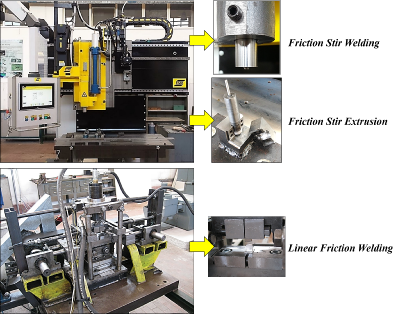
This project aims to identify technological solutions designed to optimize production processes based on the mechanics of Solid Bonding, such as Friction Stir Welding (FSW), Linear Friction Welding (LFW) and Friction Stir Extrusion (FSE). These processes are consistent with the aspects of "sustainable manufacturing technologies" for the realization of advanced components. The research involves the implementation of a holistic design approach capable of identifying optimal configurations of the process parameters as both purely technological design objectives as well as environmental impact metrics. This approach involves the integration of different "modeling and support methods and tools", such as Computer-Aided Designing (CAD), Finite Element Modelling (FEM), Design of Experiment (DoE) techniques, Response surface Methodology, Life Cycle Assessment (LCA) techniques and experimental campaigns.
2. Optimization of wastewater treatment from agro-based industries aimed at producing waste sludge enriched in PHA - Santo Fabio Corsino
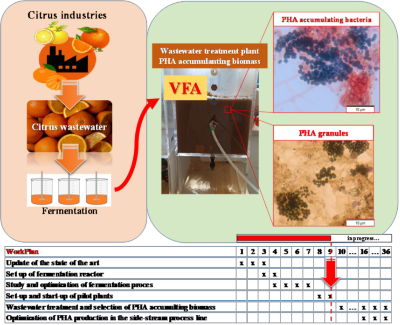
The research activity is based on the analysis of citrus wastewater treatment process along with the selection of specialized PHA-accumulating bacteria.
The experimental activity involves the analysis and optimization of those processes that occur in:
- a pre-treatment line, in which the wastewater is subjected to fermentation processes with the aim to produce volatile fatty acids necessary for PHA production (Phase 1 – completed);
- a main-stream treatment line, which is constituted by biological reactors with advanced technologies(MBR – Membrane BioReactorand SBR – Sequencing Batch Reactor), in which the treatment of wastewater and the selection of PHA-accumulating biomasses are simultaneously achieved (Phase 2 – in progress);
- aside-stream treatment line, in which the excess sludge derived from the main-stream line will be enriched in PHA(Phase 2-3).
3. Novel techniques for structural monitoring and development of adequate strategies of mitigation of vibrations and of structural reinforcement of structures belonging to the cultural heritage - Alberto Di Matteo
This research line aims at the definition and implementation of novel techniques for structural monitoring and the development of adequate strategies of mitigation of vibrations and of structural reinforcement, of structures belonging to the cultural heritage (CH), through an interdisciplinary approach that takes into account the stringent constraints required in this area. To this end, four main activities are envisaged: implementation of advanced monitoring techniques with environmental vibration tests suitable for CH; damage analysis and itspertinent evaluation through advanced methods of computational mechanics; study of innovative structural control technologies for the protection and reinforcement of works of interest for the CH; extension of “Building Information Modeling” (BIM) techniques to CH structures.
4. Design solutions for an energy retrofit of the whole neighborhood into a cluster of smart NZEBs with low carbon emissions - Francesco Guarino

The research is based on the analysis of a case-study of a cluster of buildings, aimed at the definition of design solutions to perform an energy retrofit of the whole neighborhood into a cluster of smart NZEBs with low carbon emissions, in accordance to the peculiarities of the site. The study includes the energy analysis of the building with a specific focus on the thermophysical properties of the envelope, on the properties of the HVAC system and on the energy use and generation on site. It also includes the energy modeling of the building cluster and the design of energy retrofit and decarbonization solutions, inspired by eco-design and the use of low carbon materials and technologies. The project activities currently developed are the analysis of the state of the art on the topic, the identification of the buildings cluster and its preliminary energy analysis, the development of a calculation tool aimed at modeling the effect of climate change on the energy performances of the cluster.
5. Processing of polyhydroxyalkanoates (PHA) for the production of disposable devices - Francesco Lo Presti
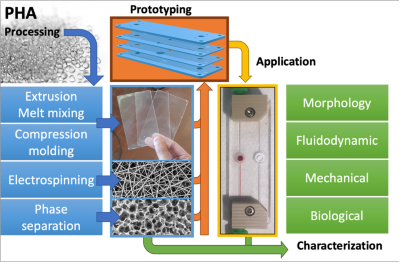
The research will focus on the processing of polyhydroxyalkanoates (PHA) alone or in blends/combination with other biopolymers and/or additives for the production of disposable devices, with particular emphasis to potential biomedical applications.In order to pursue the minimization of the environmental impact of the devices, melt-processes will be preferred for the production of films, foams, plates, membranes, sheets.
- Screening of commercially available PHAs and PHAs from UNIPA R&D sources to identify suitable candidates.
- Analysis of processing protocols for the fabrication of semi-finished PHA products.
- Chemical-physical characterization of PHA products and their biocompatibility with physiological fluids.
- Fabrication of micro/nano-structured foams/membranes to be used as scaffold for tissue engineering and elements of microfluidic circuitry.
- Prototyping of microfluidic devices by means of laser cutter and multilayer assembly.
- Morphological, mechanical, fluid dynamic characterization and validation of the biological functionality of PHA-based devices and comparison with equivalent products obtained from traditional materials.
6. Holistic approach for integrating the entire supply chain of the design of a component or product - Giulia Marcon

The purpose of this project is to implement an holistic approach which aims to integrate the entire supply chain of the design of a component or product in accordance with the Concurrent Enginerring philosophy. Three different manufacturing processes will be optimized, Friction Stir Welding (FSW), Linear Friction Welding (LFW) and Friction Stir Extrusion (FSE), through an iterative methodology based on: the definition of the design and process parameters, the list of robustness process, the implementation of experimental campaigns or numerical simulations following the Design of Experiment (DoE) techniques, the identification of best improvements of the process parameters. In addition to technological performances, the environmental impact performances will also be optimized through Life Cycle Assessment (LCA) techniques.
7. Design solutions for the conversion of groups of buildings - Filippo Pellitteri
The proposed research activity aims at defining design solutions for the conversion of groups of buildings, to be identified in the Mediterranean context, into clusters of smart NZEBs (Nearly Zero Energy Buildings), in order to contribute to the reduction of carbon emissions. As part of the aforementioned research activity, the main focus is the optimal design and management of the electrical power system architecture inside the cluster, with particular care to the following issues: sizing of hybrid storage systems; design of dc-dc and dc-ac converters based on the use of modern semiconductor technologies; implementation of power management strategies; use of innovative energy transfer methods, such as wireless magnetic induction. The effectiveness of the proposed solutions will be assessed in terms of energy self-sufficiency, reduction of energy consumption and emissions of climate-changing gases.
8. Technological solutions for a better integration of wearable devices in smart environments - Riccardo Pernice
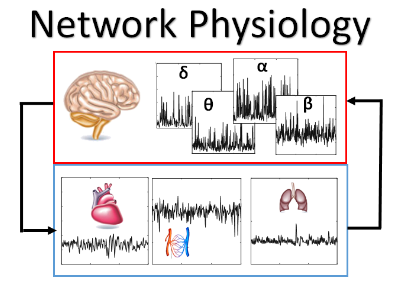
The project AIM “ID 1851228 - activity no. 2" aims to define technological solutions allowing a better integration of wearable devices in smart environments and the characterization, starting from the acquired data, of human factor in different physiopathological states. The activity foresees the design of multisensor monitoring systems and the development of algorithms for processing the biosignals acquired simultaneously from different physiological districts (e.g. electrocardiographic, photoplethysmographic, electroencephalographic, breathing signals), with the final aim of estimating the psychophysical stress level of the subject in the reference scenarios. Using the approach known as “Network Physiology”, suitable indices which reflect the connection between different districts (e.g. brain-heart interactions) will be extracted, for a better quantification of the human factor.
The results obtained up to now consist in the processing of electrocardiographic and photoplethysmographic signals acquired synchronously to extract cardiovascular and respiratory parameters of interest (e.g. pulse wave, vascular activity, heart and breath rate) and in the development of signal processing algorithms in the information-theoretic domain capable of analyzing the interaction among time series extracted from signals acquired on various physiological districts.
9. Green Chemistry - Marco Saccone
For about three decades, chemists have used green chemistry principles to approach society’s most fundamental challenges in new and innovative ways. Green chemistry can be broadly defined as an area of chemistry focused on the design and synthesis of products and processes that minimize or eliminate the use and generation of hazardous substances.
The project deals with green chemistry in two ways, namely:
1) In the development of green chemistry approaches to the formulation of coatings for metals to be applied in the naval or biomedical field.
2) In the recovery of monomers and polymers from biomasses to be used for environmental-friendly coatings.
Expected results include the selection of coatings with suitable adhesion properties and the design of good reaction conditions.
10. Development of innovative modules of polymer electrolyte membrane Fuel Cells - Andrea Zaffora
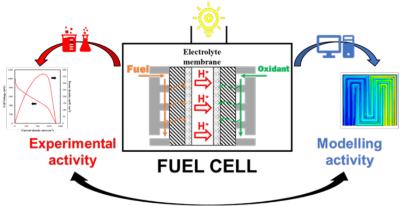
The main goal of the research project is the development of innovative modules of polymer electrolyte membrane Fuel Cells (FCs). FCs are devices that produce electrical energy converting the chemical energy of a fuel and an oxidant through a highly efficient electrochemical process with low emissions. Innovative modules development will be done through the implementation of a computational tool for the multiscale modeling of the devices, in terms of fluid-structure interaction, water management and electrochemical phenomena simulation. This activity will be coupled with an experimental one for the validation of such computational models.




